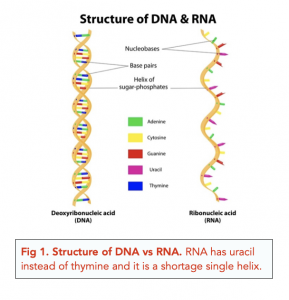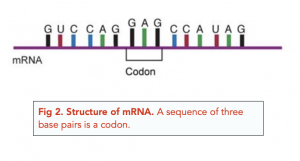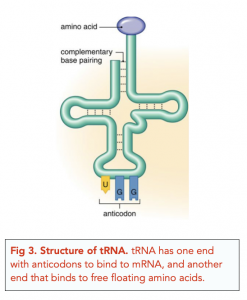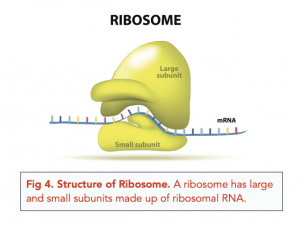Structure of RNA (A-level Biology)
Structure of RNA
Structure of RNA
- Like DNA, RNA is also made up of a polynucleotide chain.
- RNA only has one polynucleotide chain and is single stranded molecule. Compared to this, DNA is a double stranded molecule.
Components of RNA
- Below are the key components of RNA:
- RNA is made up of RNA specific nucleotides.
- RNA has a ribose sugar instead of deoxyribose.
- RNA has uracil as a nitrogenous base instead of thymine.
Bonding and structure of RNA
- the bonding and structure of RNA is similar to DNA:
- Like DNA, RNA nucleotides form a single polynucleotide chain held together by phosphodiester bonds.
- The RNA polynucleotide chain also twists and forms a single stranded helix.
- RNA is much shorter than DNA.

Types of RNA
There are almost 30 different types of RNA, of which 3 are important to know.
Messenger RNA
- mRNA transfers genetic information from DNA. We have previously established that RNA is responsible for passing on genetic information from DNA so that proteins can be made. This is done by a specific type of RNA called messenger RNA (mRNA).
- mRNA is made in the nucleus and travels into the cytoplasm. DNA is in the nucleus of a cell; however, the organelles responsible for making proteins are in the cytoplasm. As DNA itself cannot move out of the nucleus due to its large size, the relevant portion of the DNA is copied into an mRNA in the nucleus which then travels into the cytoplasm.
- Three consecutive nucleotides in an mRNA are called a codon. Like DNA, mRNA is made up of nucleotides. However, in mRNA, a sequence of three consecutive base pairs are grouped together as a “codon“. Each codon codes for one specific type of amino acid.

Transfer RNA
- tRNA binds to mRNA. Another type of RNA in the cytoplasm, transfer RNA (tRNA) is able to bind to the codons in the mRNA. This is because tRNA has anticodons, sequences of three consecutive base pairs which are complementary to the bases in mRNA’s codons.
- tRNA brings amino acids needed for protein formation. The other side of tRNA has an area where free floating amino acids can bind to, thus, tRNA is responsible for bringing in amino acids to to the organelle where proteins are being formed.

Ribosomal RNA
- Ribosomal RNA are the subunits on a ribosome. Ribosomes are the organelles where proteins are formed in a cell. It consists of a large and small subunit that is made up of ribosomal RNA (rRNA).
- rRNA catalyses peptide bond formation. As amino acids are added along the growing peptide chain, the rRNA in ribosome helps peptide bonds form by catalysing the reaction.

RNA stands for ribonucleic acid and it is a type of biomolecule that plays a critical role in protein synthesis. RNA is made up of a sequence of nucleotides, which are the building blocks of RNA.
There are several types of RNA, including:
Messenger RNA (mRNA): mRNA carries genetic information from DNA to ribosomes, where it is translated into a protein.
Transfer RNA (tRNA): tRNA transfers amino acids to the ribosome during protein synthesis.
Ribosomal RNA (rRNA): rRNA makes up a significant portion of the ribosome and plays a critical role in protein synthesis.
Small Nuclear RNA (snRNA): snRNA plays a role in splicing pre-mRNA, which involves removing non-coding sections of mRNA.
MicroRNA (miRNA): miRNA regulates gene expression by binding to specific target mRNAs and causing them to be degraded or preventing their translation into protein.
RNA is structured as a single strand of nucleotides that fold into specific shapes to form secondary and tertiary structures. These structures play a critical role in the function of RNA, including facilitating interactions with other RNA molecules or proteins. RNA can also form base pairs with complementary RNA or DNA sequences, allowing it to form double-stranded structures.
RNA is different from DNA in several key ways, including:
RNA is usually single-stranded, while DNA is double-stranded.
RNA is composed of ribonucleotides, which contain a ribose sugar, while DNA is composed of deoxyribonucleotides, which contain a deoxyribose sugar.
RNA contains the nitrogenous base uracil instead of thymine, which is found in DNA.
RNA plays several critical roles in the cell, including:
Carrying genetic information from DNA to ribosomes for protein synthesis
Regulating gene expression through the action of miRNA
Participating in the splicing of pre-mRNA to remove non-coding sections
Acting as a structural component of ribosomes and other cellular structures.
RNA is synthesized in the cell through a process called transcription. During transcription, an enzyme called RNA polymerase reads the genetic information in DNA and synthesizes a complementary RNA molecule. The resulting RNA molecule is called pre-mRNA and can undergo further processing, including splicing, to remove non-coding sections before it is translated into a protein.





Still got a question? Leave a comment
Leave a comment